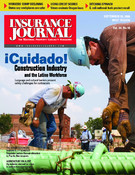Employers are paying more attention to worker and workplace safety, which is helping states like Hawaii and Wyoming to reduce its workers’ compensation rates.
Hawaii, Washington, Wyoming bringing down workers’ comp rates
Hawaii, Washington and Wyoming proposed lowering workers’ compensation rates in their states from 2 percent to 12.3 percent.
The Hawaii Department of Commerce and Consumer Affairs’ Insurance Division announced that the National Council on Compensation Insurance (NCCI) filed a request for a decrease of 12.3 percent in the workers’ compensation loss costs. The filing would affect premiums beginning Jan. 1, 2007.
Hawaii Insurance Commissioner J.P. Schmidt attributed the rate decrease to a continuing reduction in the number of claims filed in 2004 (the last year complete data is available, which helps to determine trends for 2007). Last year, the commissioner approved a decrease of 18.2 percent in loss costs as evidence began showing a significant reduction in claims.
“Claim frequency is down due to the great efforts by Hawaii’s employers in providing a safer work place for workers,” Schmidt said. “We have made a concerted effort to encourage employers to implement work place safety programs and thereby qualify for insurer’s discounts.”
Additionally, the Department of Labor and Industrial Relations, Hawaii Occupational Safety and Health (HIOSH) Division made great strides toward partnering with Hawaii’s employers and labor organizations in enforcing the state’s workplace safety and health laws, the Division said. That collaborative effort led to exemplary safety and health programs that directly resulted in less workers’ compensation claims being filed.
Medical and indemnity costs also showed a slight decrease. The Division indicated that decrease should bring some additional relief in 2007 to Hawaii’s businesses that have had to pay some of the highest workers’ comp premiums in the nation. According to a 2003 Oregon national study, the only states with higher rates than Hawaii were California and Florida, both of which recently enacted significant workers’ comp reforms.
In Washington, the Department of Labor and Industries proposed lowering workers’ compensation rates next year by an average of 2 percent, the first general rate reduction in six years. It is expected to save employers about $31 million in premiums. A final decision on rates will be made in late November following four public hearings.
Gov. Chris Gregoire said the lower rates are an indication that the state’s economy is strong.
L&I Director Gary Weeks, agreed, crediting the proposed rate reduction on a strong economy, good return on investments and L&I’s ability to control its health care costs. He said the rate proposal is in keeping with his and the governor’s goal of making minor annual adjustments in the rates to avoid the kind of big rate increases that occurred in 2003 and 2004.
Weeks said his rate proposal would have a minimal impact on the State Fund’s large, $1.7 billion contingency reserve – the difference between assets and anticipated liabilities over the next 40 to 60 years.
L&I’s proposal for a 2 percent rate reduction includes:
•Lowering the average Accident Fund rate by 5 percent. Employers contribute premiums to the fund, which pays partial wage-replacement, disability and pension benefits to workers injured so severely they miss work.
•Leaving the average Medical Aid Fund rate the same as it is this year. Employers and workers contribute equally to this fund, which provides health care, as well as vocational-rehabilitation counseling, to injured workers.
•Increasing the Supplemental Pension Fund rate by 7 percent. This fund pays cost-of-living increases for injured workers receiving long-term wage-replacement benefits. Employers and workers contribute equally to it.
The proposed 2007 workers’ compensation rate is estimated to bring in $1.62 billion in premiums – about $31 million less than this year’s rates are expected to produce.
Meanwhile, Weeks announced he will be leaving L&I, effective Oct. 13.
In Wyoming, the Department of Employment proposed a workers’ comp rate decrease of 5 percent across the state. Some industry classes with better-than-average loss experiences could see rates drop as much as 10 percent, while no industry classes would see an increase under the state proposal.
Gov. Dave Freudenthal said the decrease is good news and further establishes Wyoming’s business-friendly climate.
“I’m pleased that safety played a role in the decreasing rates, as the health and well-being of the Wyoming work force is a tremendously important factor in keeping Wyoming families strong,” Freudenthal said.
Cindy Pomeroy, director of the employment department, said losses across the state are showing signs of tempering. Pomeroy also said that with more people working in Wyoming, there’s more money coming into the workers’ compensation fund.
“A renewed commitment by the employers and employees of Wyoming to work safely also has contributed to the decrease in workers’ compensation rates,” Pomeroy said.
The Associated Press contributed to this article.
Topics Workers' Compensation Washington
Was this article valuable?
Here are more articles you may enjoy.


 Hyundai, Kia Agree to Retrofit 7 Million Vehicles to Address Theft Concerns
Hyundai, Kia Agree to Retrofit 7 Million Vehicles to Address Theft Concerns  Insurance Industry ‘Megadeals’ Dominate 2025, Says PwC
Insurance Industry ‘Megadeals’ Dominate 2025, Says PwC  McKinsey Plots Thousands of Job Cuts in Slowdown for Consulting Industry
McKinsey Plots Thousands of Job Cuts in Slowdown for Consulting Industry  State Insurance Legislators ‘Greatly Disturbed’ by Trump AI Regulation Order
State Insurance Legislators ‘Greatly Disturbed’ by Trump AI Regulation Order 


